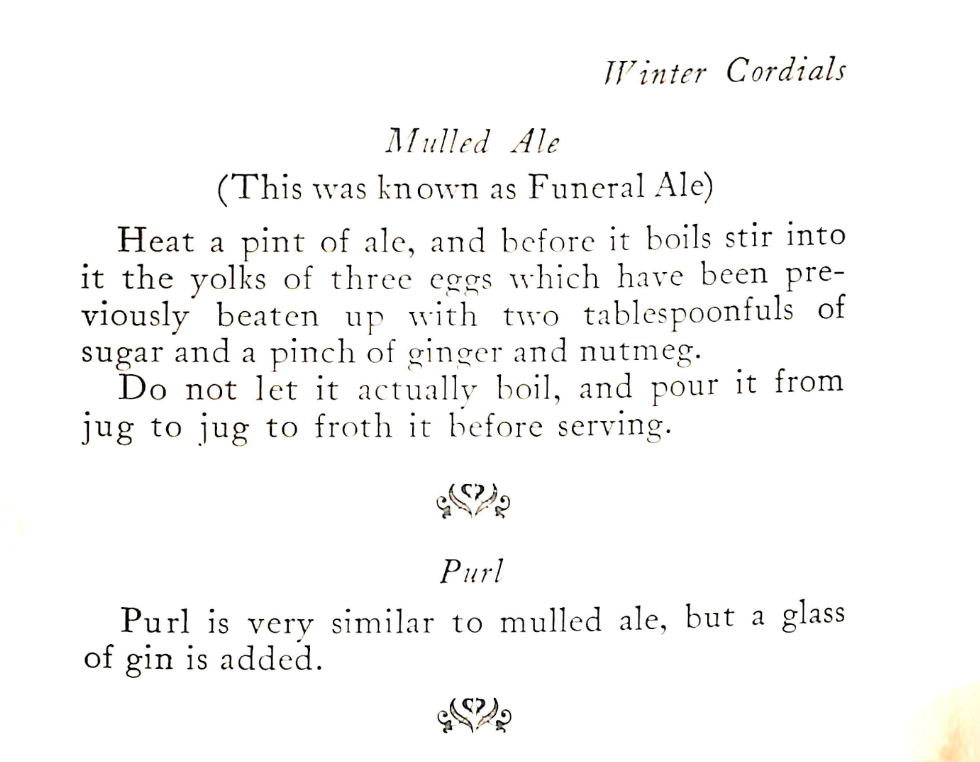In modern day bar culture, the Purl is often described as ale with a shot of gin added. This simple combination is said to date back to 18th and 19th century British bar culture. The gin of the era would have been an Old Tom style and the ale would have likely been a British Bitter and served at cellar temperatures.
However, the history of the Purl as told by the cocktail books that document the era tell of a far more complex drink, that mostly doesn’t resemble this simple drink.
It started as a plague remedy, where to a 17th century Londoner a Purl would have been ale or wine with wormwood added. Later, consumed recreationally, sometimes in the morning and to excess, spirits began to be added. The drink became more complex, adding eggs and spices— to the point where it looked nothing like the original. Then in the 20th century, we saw the occasional choice of gin as the added spirit, become the canonical spirit. This led to the modern day where purl simply means ale + gin.
Early recipes for the Purl— or “Early Birds”

William Terrington’s 1869 volume, Cooling Cups and Dainty Drinks is often described as “the first British cocktail book.” It includes a recipe that features warmed beer, multiple eggs and was not automatically assumed to contain gin. While that glass of spirits could be gin, it could also have been brandy, whisky, or any other spirit common in a 19th century British bar.

In other words, the 1869 recipe for a Purl is a Flip. Here we see a recipe for the Rum Flip from Jerry Thomas’s 1862 Bartenders Guide.

William Terrington’s manual contains another recipe for a similar drink that does specifically call for gin and ale. While still a type of flip, the Ale Cup (one of multiple drinks with the name) is a dedicated gin drink.
“Pots of Purle” and wormwood

From The Grub Street Journal, September 1733.
Earlier accounts of the Purls and Purl-shops in London tell of a drink that was also not gin specific. Before gin was common, a Purl was a beer mixed with wormwood, and sometimes taken as a morning constitutional.
As with modern-day “morning cocktails” this drink is more than occasionally mentioned as a disparaging vice. Such as in this character attack from a 1733 newspaper, where smoking, gin drinking and purl consumption went hand-in-hand.

1665’s Directions for the Prevention and Cure of the Plague Fitted for the Poorer Sort features diet advice, which on page 1 recommends having “a draught or two of Purle…especially in the morning.” Given the audience of this book was “poorer” sorts, the presence of Purle here suggests that it was rather inexpensive.

Here, the Cider industry feels somewhat left out and affirms that a purl wide cider is just as good as a purl with ale. From 1684’s Aphorisms upon the New Way of Improving Cyder…

Here we again see in the 1690 An English Herbal, the benefits of wormwood being drank in a Purl.
The Modern Purl— Or the emergence of gin
In the 20th century, wormwood is long gone in cocktail recipes. But you also see the slow disappearance of the drink’s “flip” roots. The eggs start to disappear, but the warming of the ale remains.
We also see that Purl converges on the modern definition— gin and ale. Though the addition of bitters remains a key part of the recipe.

Summer Drinks and Winter Cordials (1925)

From The Art of Mixing Drinks (1935)

From Cocktail and Wine Digest’s The Barman’s Bible (1966)

You might find the following historical recipes interesting:
The New Art of Brewing and Improving Malt Liquors by William Ellis (1761):
https://www.google.de/books/edition/The_New_Art_of_Brewing_and_Improving_Mal/lB1izdJz3xkC?hl=de&gbpv=1&pg=PP4&printsec=frontcover
The Publican’s Friend, and Sure Guide to Do Well by S. Moor (1812):https://books.google.de/books?id=vd4qD2bkEAcC&hl=de&pg=PA227#v=onepage&q&f=false
Both sources mention gin as an optional ingredient.